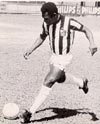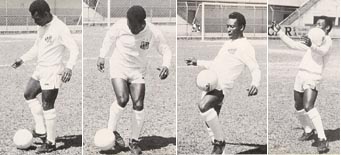|
 Play Soccer with Pelé
Play Soccer with Pelé
6. Stopping or "Killing" the Ball
Stopping or "Killing" the ball is the art of receiving it
and keeping it "captured" under your control. Obviously you don't always
receive the ball at the same height or at the same speed. It can arrive high,
medium height, low, rolling, bouncing, quickly or slowly. You should be able to
control it immediately and not let it get away from you. To do this you can use
the sole, top, inside or outside of your foot, your heel, shin, thigh, stomach,
chest, shoulder and head, whether you are running at the time or stationary.
The first secret of a successful killing is to relax the part of your body
which is going to stop the ball, moving backwards in the same direction as the
ball is traveling. When you are stopping the ball on your foot, keep your
weight on your support leg. When the ball reaches your boot, move your foot
gently back, thereby absorbing the impact. You must learn to stop the ball
with the inside of both your feet. Your toe should be pointing upwards, making
the area of impact as large as possible. Your weight should be on your support
leg, your arms moving freely to maintain your balance and keep looking at the
ball until you've caught it. Point your toe inwards when you are stopping the
ball with the outside of your foot.

To stop the ball with your thigh, make sure your support foot is firmly on the ground
and the leg is loosely flexed. It depends on the trajectory of the ball, but
you usually have to lift your other leg so your thigh is at waist height. If it
is a low ball, you should not lift your thigh so high. It is a question of coordination.
When you have mastered this, you should be able to make the ball do what you
want, when you want. There is a little trick which will help you stop the ball
with your chest. Just before the ball hits you, fill your lungs with air and
breathe out on impact, at the same time bringing your arms and shoulders
forward. This co-coordinated movement makes your body form a sort of
shell into which the ball can fall. If the ball descends almost vertically on
top of you, lean your body and head right back, keeping your balance by
distributing your weight on both feet and the ball will 'stick' to you. If you
stop the ball with your shoulder you can also pass it from there to a teammate
or drop it to your own feet and have a quick shot at goal. The opportunity for
this particular tactic usually occurs when you are jumping. Whether you are
able to stop the ball on your shoulder and then follow through with a pass
depends a lot on constant training. As the ball hits your retreating shoulder
you have to turn suddenly, thereby propelling the ball to a team-mate.
Get yourself right under the descending ball when you want to stop it with your
head. Keep your eyes open all the time. As it hits your forehead, flex your
legs, with your feet apart, pushing your hips forward and keeping your body
straight and your arms open. Move your head down towards your shoulders as the
ball hits it, thereby taking the speed out of the ball. The whole secret is to
position yourself right under the ball and let your legs give at the moment of
impact. You can begin to learn this skill by practicing alone. When you have
begun to master it, ask someone to throw the ball for you to stop. Don't forget
that you won't achieve anything without working at it.
When the ball bounces off the ground at you from a little further away, you can kill it
with your stomach. You have to place yourself in the path of the oncoming ball
with your feet well apart with the weight of your body divided between them and
keep your legs flexed. Keep your arms by your side and don't take your eyes off
the ball. When the ball hits your stomach, lean back to absorb the force and
move one foot well back so your leg in front is almost straight. At the same
time bend the upper part of your body forward, thus forming a concave shape
into which the ball will fit.
Another very effective way of stopping the ball is killing it with your heel and ankle
on the outside of your foot. This maneuver not only puts you in control of the
ball, but also enables you to bring the ball round in front of you for a pass,
or a shot at goal. The weight of your body should be borne by your flexed
support leg. Your body should be bent forward and leaning slightly to the same
side as your free leg. To help you maintain your balance keep the arm that is
on the side of your support leg forward and hold the other arm lightly back.
The foot of your free leg should be parallel to the ground and held so that the
outside is facing the oncoming ball. When the ball hits the outside of your
foot, lift your leg a little higher and lean a bit further forward. If you
flick the ball from there it will curl in a semi-circle and land in front
of you. During all these maneuvers you must look fixedly at the ball as if you
were hypnotizing it. This way of stopping the ball can be practiced with a ball
hanging in a doorway on a piece of string or elastic. If you are practicing on
a football pitch, you can hang the ball from the crossbar of a goal. It's a
great one to learn because it looks good and is very quick.

Finally I will tell you how to stop the ball with the top of the foot, which resembles a
movement in ballet. You can practice this one on your own as well. This
"killer" is a real beauty, but it requires speed, precision and an excellent
sense of timing. As usual your support leg should bear your weight. The other
leg must be lifted as high as possible, but keep it slightly bent the higher
the better. When your leg is well up in the air, lift yourself up onto the toe
of your support foot. The ball lands in the cup formed between the shin and
toes of your lifted leg. At that moment bring your leg down, at the same speed
as the descending ball at first and then slower and slower, deadening the speed
of the ball. When you lift and lower your leg, the center of gravity moves back
a little. The fact that your body is leaning forward and your arms are open
ensures that your body is correctly balanced. Special attention must be paid to
your eyes, which should follow the ball during the entire action. Of course the
height you lift your leg depends on the height at which the ball is coming. The
higher the ball, the higher the leg must be raised.
All these ways of "killing" the ball must be practiced while running and standing still.
The better you become at controlling the ball, the more it will be your friend.
The more ways you learn of getting and controlling the ball, the better the
chances of your team.
Next Chapter: 7. Steering the Ball
Previous Chapter: 5. The Feint and the Dribble
Table of Contents
Top of Page
|

 Rate our web site. Answer our Questionnaire.
We care what you think. Click here
Rate our web site. Answer our Questionnaire.
We care what you think. Click here



 Rate our web site. Answer our Questionnaire.
We care what you think. Click here
Rate our web site. Answer our Questionnaire.
We care what you think. Click here

